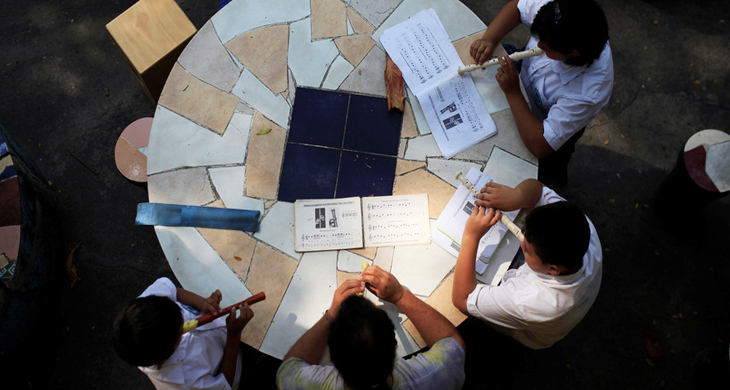
Inclusive Innovations in Education Praxis
Locating the missing pieces in the puzzle of education for poverty alleviation.
Posted On Friday, May 3, 2019 by Ritika A. Kukreja under Sustainable Development Uncategorized

Written by Ritika A. Kukreja
What would your first course of action be if you were informed that there are approximately ten million possibilities to locate the next Hawking, Kahlo or Ramanujan in some of the globe’s most deprived neighbourhoods? Assuming principles of opportunism, the world will scramble to identify and provide these emerging talents with the finest of opportunities to strengthen their potential whilst pitching them as the success story of the decade. Now, envision that we have hundreds of millions of these opportunities to help children tap into their true potential and improve their livelihoods. Yet, with each child that we fail to educate, we elude an opportunity – 617 million to be specific1 .
The provision of education has incessantly been positioned at the crux of national development policies and strategies for poverty reduction and will continue to be recognised as a fundamental pillar for socioeconomic liberation. The further fixation with increasing enrolment rates and exemplifying standardized test scores across decades has also resulted in more children attending school than ever before – particularly when we deploy a gender lens. Yet, if 6 out of 10 children worldwide are not able to demonstrate the minimum level of proficiency expected across their age group, we need to introspect whether the eminent pillar of poverty alleviation requires revision.2 Moreover, the statistics essentially highlight the alarming ‘learning crisis’ occurring globally – given that two-thirds of children who are failing to demonstrate minimum proficiency are already in school and can be supported following the adoption of appropriately designed measures.3
With the surge of two-dimensional initiatives – which aim to address educational concerns superficially from either a supply or enrolment lens to improve individual nations’ statistics - we are globally witnessing persistently low levels of equitable learning. Hence, it is necessary to foster creative, innovative partnerships between academics and grassroot practitioners from the development discourse, and governments, ministries, policy specialists and NGOs in order to identify and intricately curate the ‘third-dimension’ of initiatives which appropriately correspond to the state and national level issues in the educational sphere.
Essentially, despite alternative tactics being devised by governments to increase marginalised children’s access to quality education, the absence of innovation in education policies and their (in)ability to cultivate environments conducive to learning will hinder the genuine role that ‘education’ can adopt in reducing inter-generational poverty. For instance, consider the Government of Delhi’s recent initiative which requires all private schools in the city to reserve 25 percent of their admissions for socioeconomically weaker sections. The commendable initiative addresses the issue from an access lens – whereby children who may otherwise enrol in inadequate government schools are given the opportunity to study in renowned, well-equipped schools with qualified teachers. Whilst the strategy provides magnitudinous opportunities to children from marginalized backgrounds, it is imperative to evaluate the efficacy of these campaigns through a critical lens which perpetually advocates for evidence-based innovations. By facilitating their access to better quality schools, opportunities for growth and statistics in reports may advance, however it is crucial to analyse and explore the learning experiences of these groups within the private classroom setting through a capabilities approach. Though it is one step in the right direction, if the efficacy of educational opportunities in mediating inter-generational barriers is to be evaluated and improved, policy practitioners must further consider the underlying social contexts accompanying children to classrooms. It is thus instrumental to reflect on how likely it is for these dynamics to significantly influence their comprehension of the curriculum, their achievement and their social integration in schools. By reviewing theoretical frameworks and empirical data, it is noted that class participation, comprehension of the curriculum material and learning outcomes among marginalized students are significantly lower than that of their counterparts even in well-resourced environments.4 Ergo, it is perhaps time we accept, that increasing the enrolment of socioeconomically children in schools is simply not enough to ensure their holistic educational wellbeing. If we truly aim to provide them with equal opportunities for growth, we must now direct discourse towards the factors which hinder or facilitate their in-school capabilities.
For instance, in broadly acknowledging that the learning crisis is not limited to developing nations with vivid levels of absolute poverty, we may be able to draw upon the elements which shape learning experiences across the varying socioeconomic constellations. Taking a global, child-centred perspective to support this, a study conducted by Save the Children and the Joseph Rowntree Foundation in Scotland found that merely 14 percent of variation in student performance pertains to school quality.5 Rather, the majority of this variation is accounted for by ‘other factors’, which need to be decoded in order to raise achievement and overall educational outcomes for all. This suggests that although access to quality education is a laudable step forward, we cannot merely end our determinations at placing disadvantaged children in school. A multitude of alternative factors interact to determine the educational success of marginalised students – from opportunities for out-of-school activities and field trips, to the cost of uniforms, meals, stationary and other materials required for the overall educational experience. Thus, in order to construct effective policies and praxis at each level of the education system, it is crucial to embed an understanding of the inherent factors shaping the social differences in education and learning.
Furthermore, it is essential that we continue to explore innovative pedagogies through which learning can take place for all through various mechanisms, in order for education to endure its prominence and instrumentality in expanding capabilities and opportunities, and thus eradicating inter-generational poverty. Following the introduction of various commendable developmental initiatives designed by state and non-state actors across the globe – from the Museum School in Bhopal, India to Tostan, a community development programme transforming education across West Africa, it is imperative to learn from these enterprises as a global community. By unpacking the systems devised by successful poverty alleviation platforms, we can identify the presence of literacy/learning programmes tailored to the communities they serve as a reoccurring element irrespective of the development domain they operate in. Thus, perhaps the missing piece of the incessant puzzle can be located in grassroot organisations, which can further be applied to schemes on a national and international level.
Healthcare, education and employment have been positioned as the drivers of poverty alleviation for decades. However, we must constantly critique our efforts from the perspective of the groups directly involved. How can we design multidimensional initiatives which do not perceive poverty from a top-down level, but rather draw from, and authentically unpack the experiences of these groups? Through innovative praxis, we must devise strategies in coalition with them to effectively reflect their requirements. Our efforts towards poverty alleviation thus, may only advance if we begin to explore innovative praxis through education and pedagogy – which further challenges the inter-generational reproduction of socioeconomic barriers.
References
- 1. Data from the UNESCO Institute for statistics show that globally, 617 million children and adolescents (i.e. 6 out of 10) are not achieving minimum proficiency levels in Mathematics and Reading. For more of the actual figures estimated, including regional estimates, please see UIS Fact Sheet No. 46 “More Than One-Half of Children and Adolescents Are Not Learning Worldwide”, September 2017. children-not-learning-en-2017.pdfhttp://uis.unesco.org/sites/default/files/documents/fs46-more-than-half-
- 2. UNESCO. 2017. "Counting The Number Of Children Not Learning Methodology For A Global Composite Indicator For Education". Information Paper No. 47. Canada: UNESCO Institute of Statistics. http://uis.unesco.org/sites/default/files/documents/ip47-counting-number-children-not-learning-methodology-2017-en.pdf.
- 3. http://uis.unesco.org/sites/default/files/documents/ip47-counting-number-children-not-learning-methodology-2017-en.pdf.
- 4. Joseph Rowntree Foundation. 2007. "Experiences Of Poverty And Educational Disadvantage". JRF Research And Development Programme. London: JRF. https://www.jrf.org.uk/sites/default/files/ jrf/migrated/files/2123.pdf.
- 5. Ibid

Ritika A. Kukreja
Research Coordinator:
Ritika A Kukreja is a Research Coordinator at Global Policy Insights, with a focus on Sustainable Development. Prior to joining GPI, Ritika graduated with an MPhil in Education and International Development from the University of Cambridge. During her time at Cambridge, Ritika conducted an independent primary research project in India which sought to understand the interactions between politics, religion and communalized education. Ritika also holds a Bachelors in International Development from King's College London, during which she directed her research towards analyzing grassroots democratic institutions and informal political networks in India's most deprived neighborhoods. To cultivate an understanding of public health systems, Ritika was also awarded a scholarship by the National University of Singapore to participate in an intensive course which also involved volunteering in primary healthcare centers in rural South India.
Recent Articles
- India's March for Sustainable Future
- Water Insecurity in India
- A New Paradigm in the Financing of Solar Energy Projects
- Land Management: A step towards mitigating Land Degradation
- Impact of COVID-19 on Water Issues and the Way Forward
- Humanity better off with world order without ‘Chinese characteristics’
- Models to Make Vocational Training Work in India
- Will Seed Bill 2019 deliver the goods?
- Stubble Burning Farmers: Architects of Delhi’s Breathing Woes, or Hapless Scapegoats?
- Does India Need More Policy Action for Its Senior Citizens?
- Creating a future-proof curriculum for the digital age
- Policymakers, wake up! Floods in Chennai are not Alarm bells, they are explosions
- 'Environmental Finance — Private Capital and Private Profits for Public Gain— Pretty Promising, though not without Pain'
- Inclusive Innovations in Education Praxis
- Antibiotic Resistance: Fighting a Multi-Headed Demon
